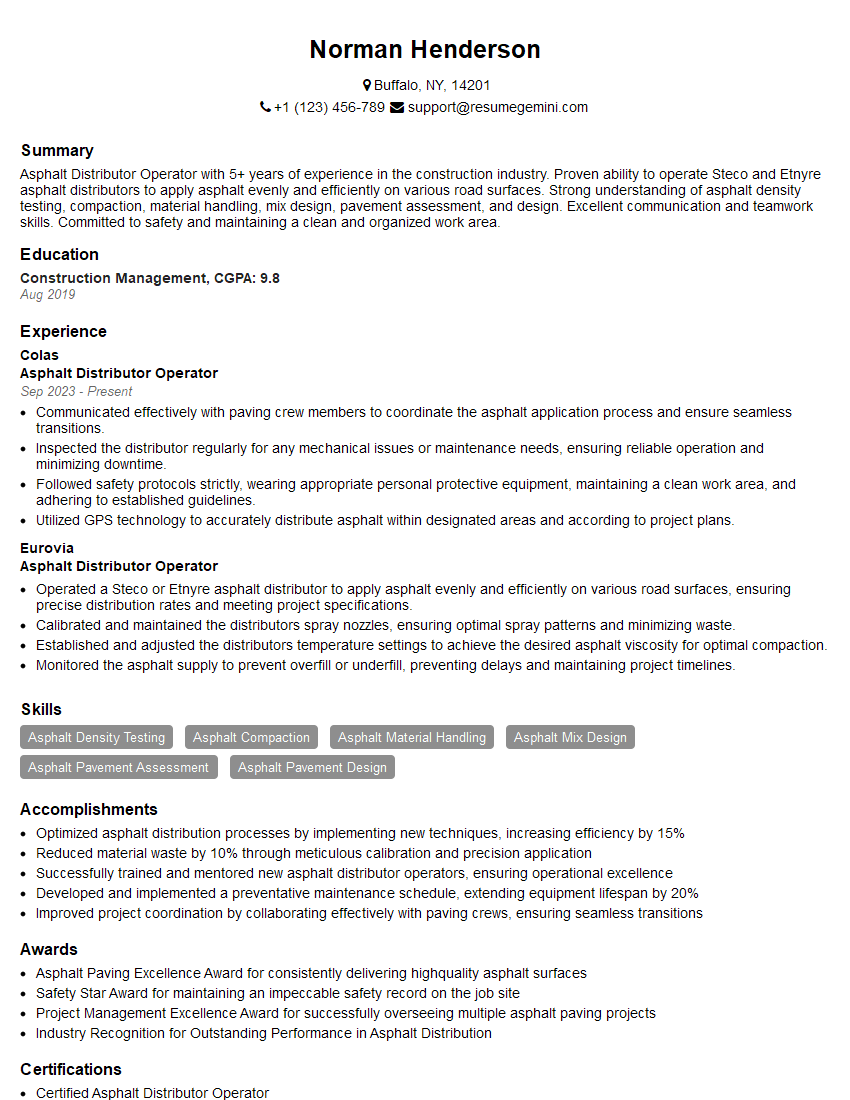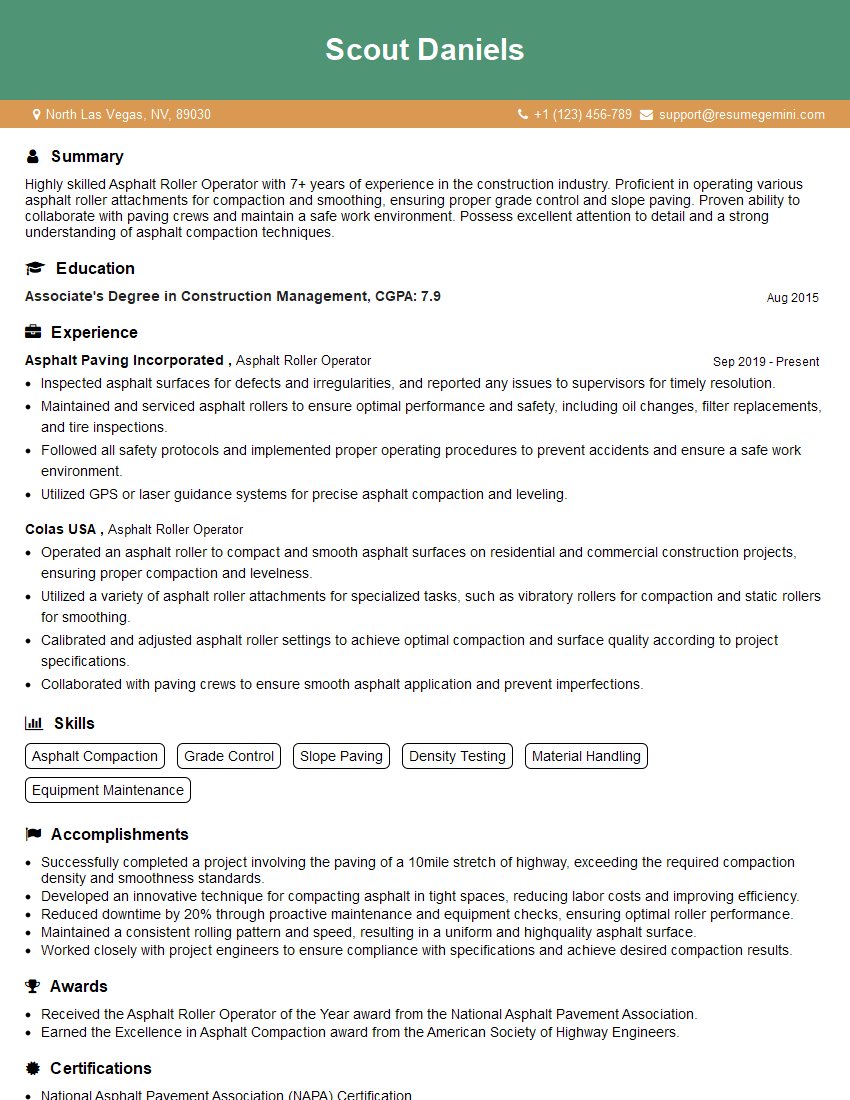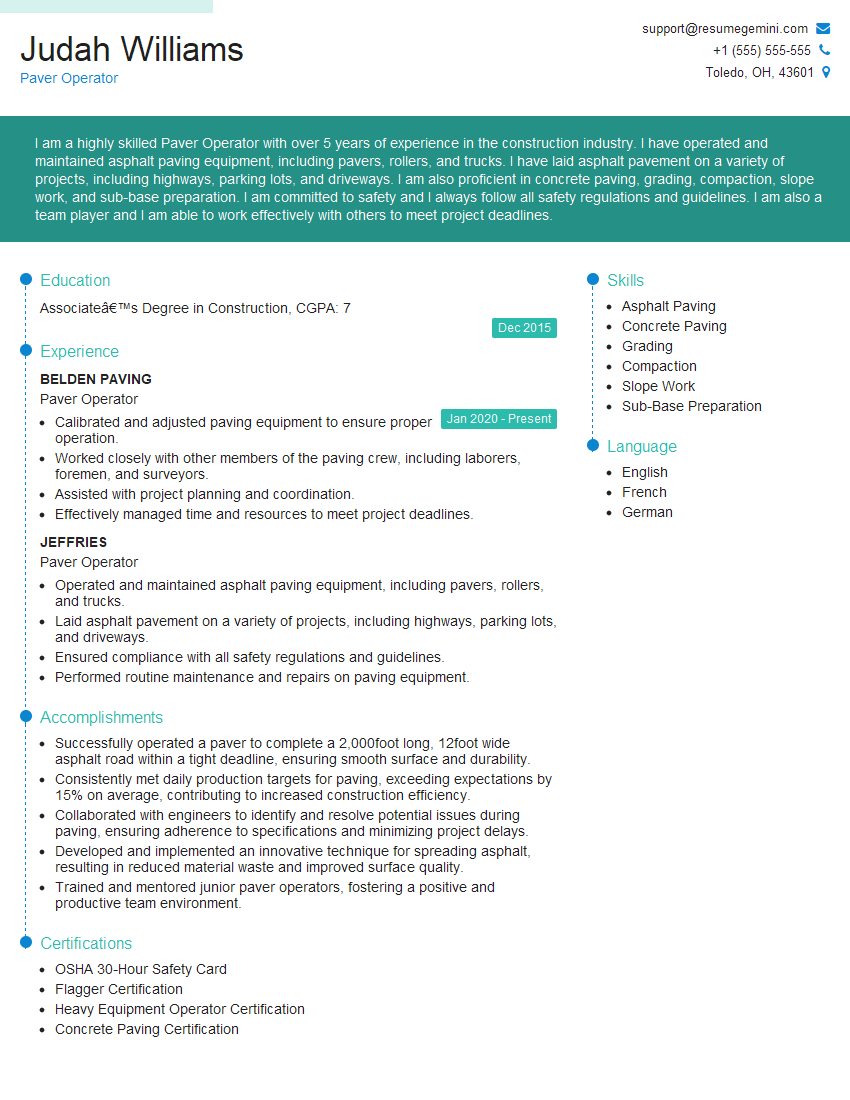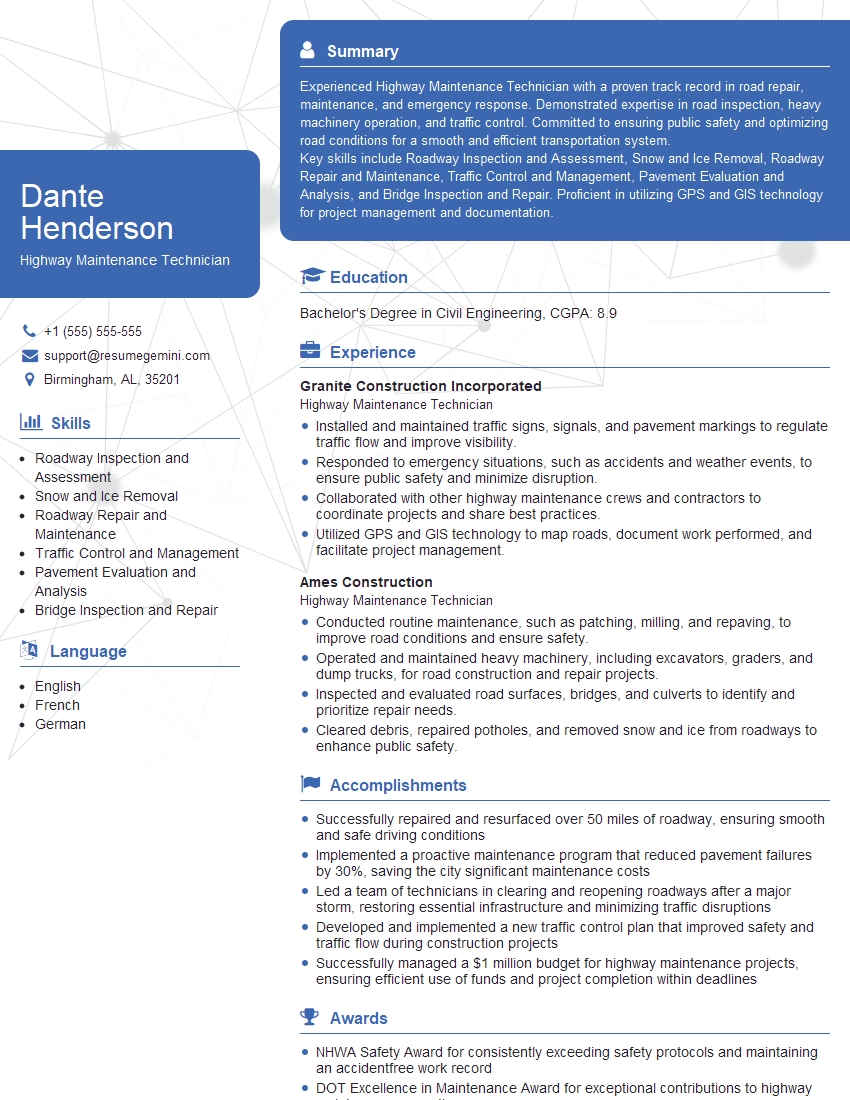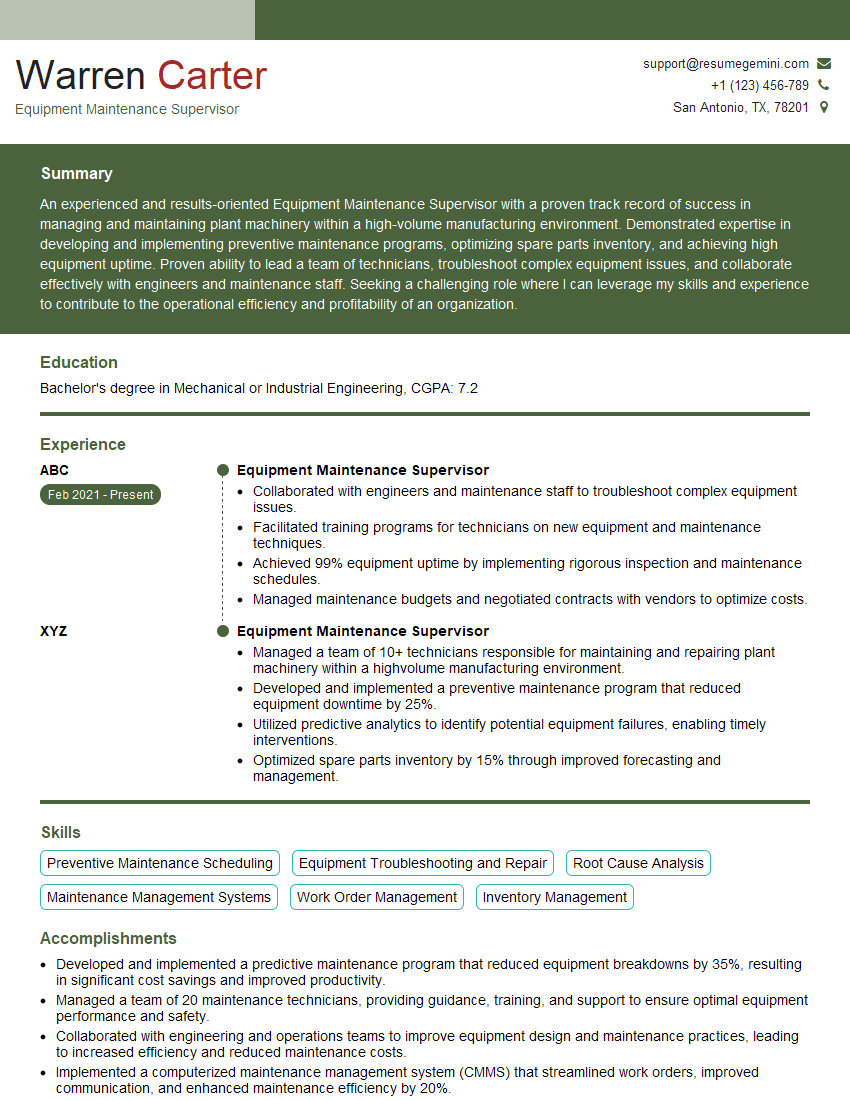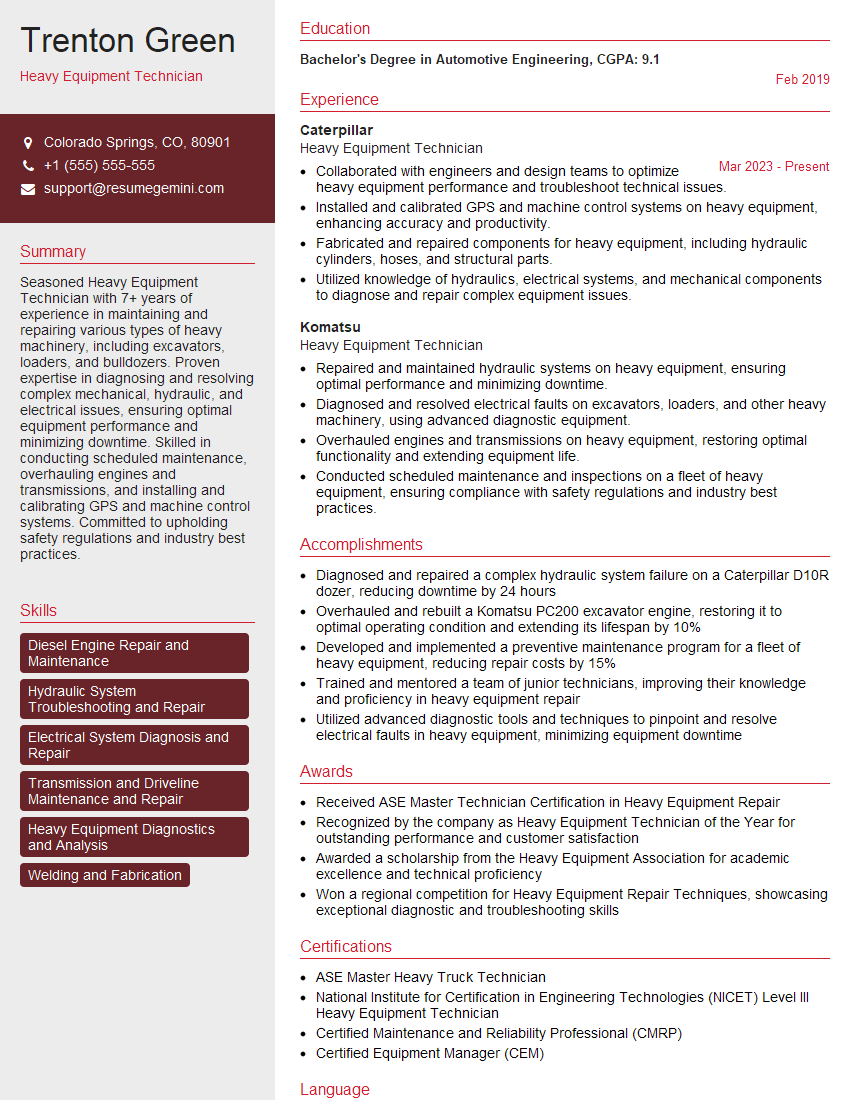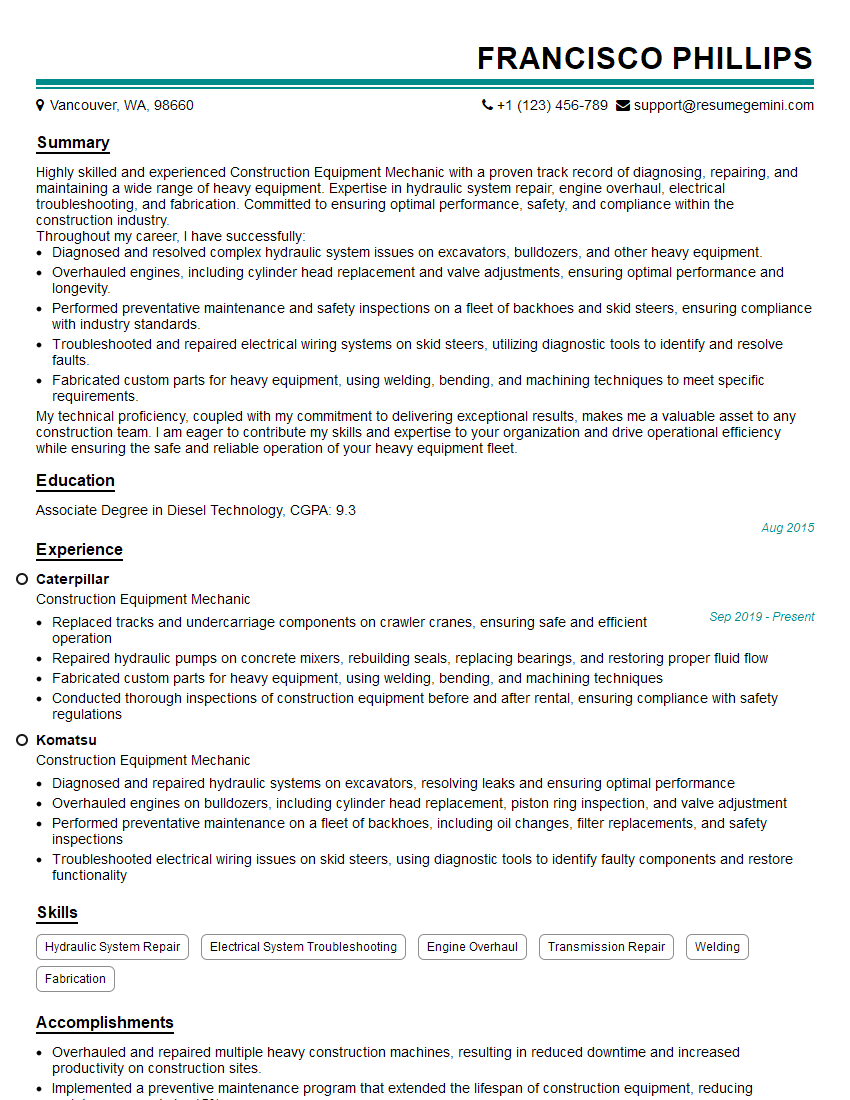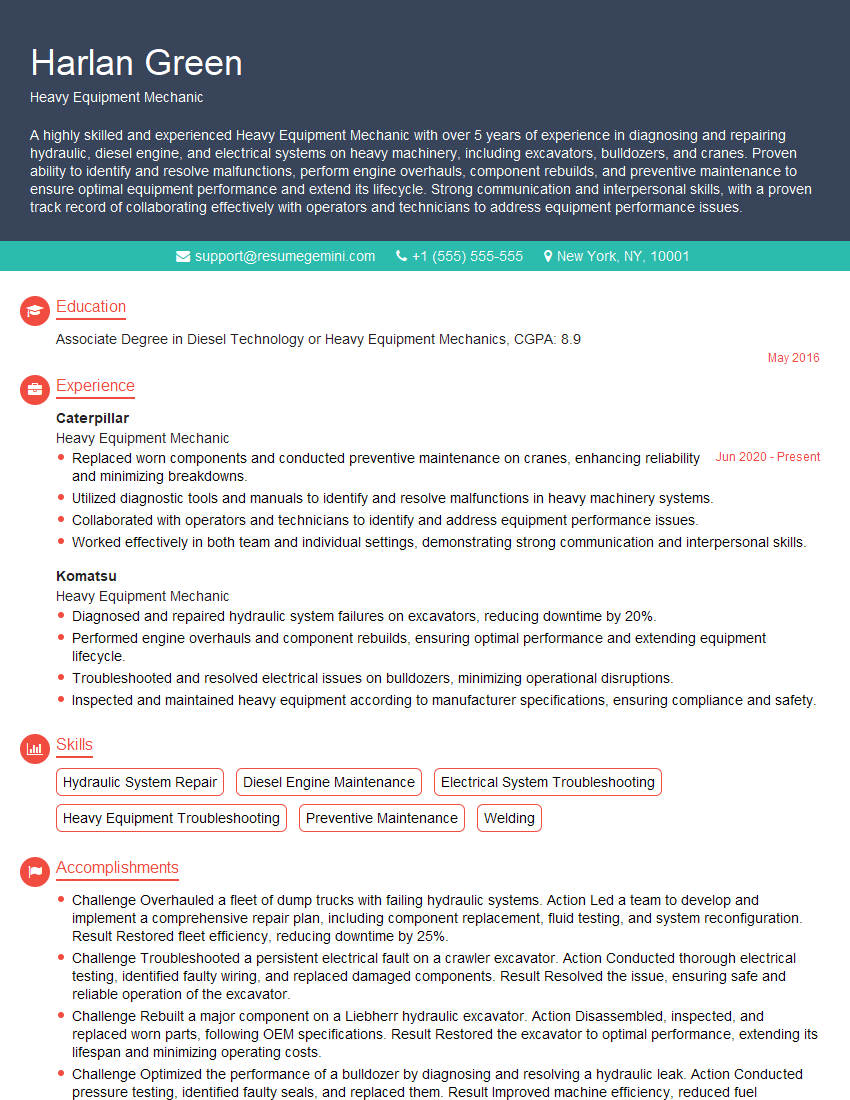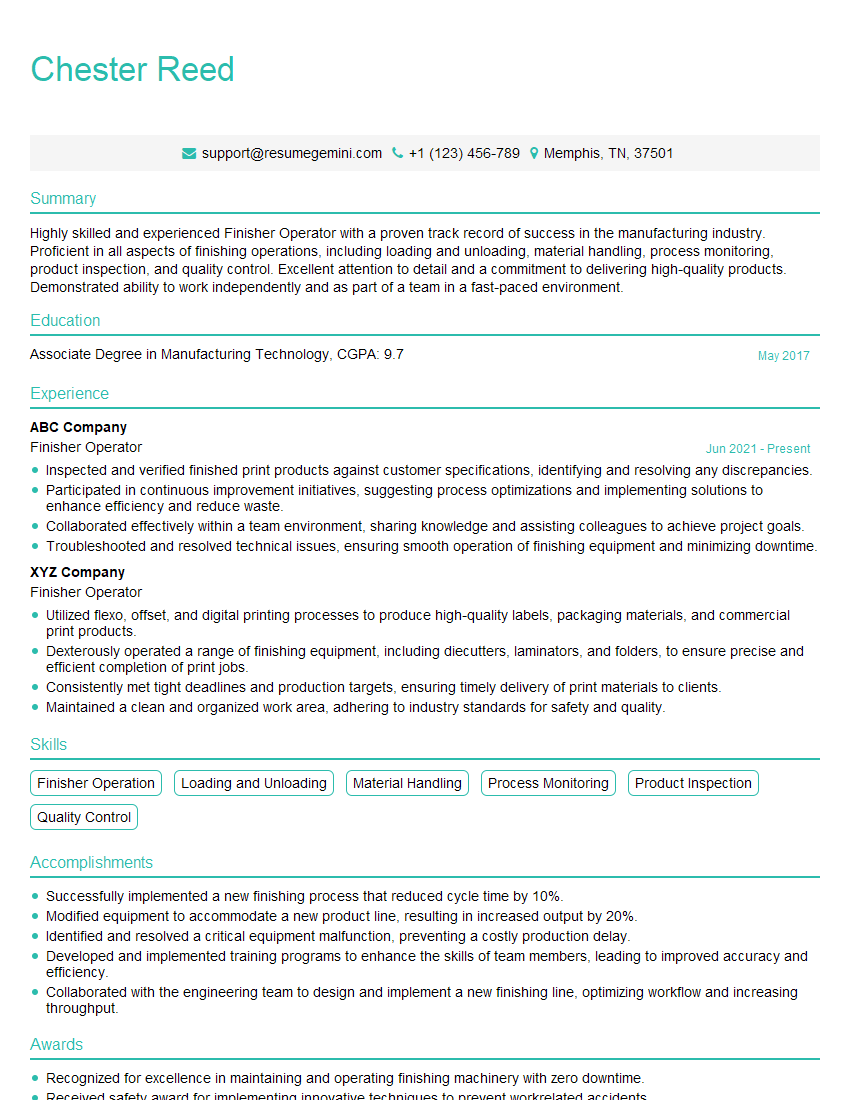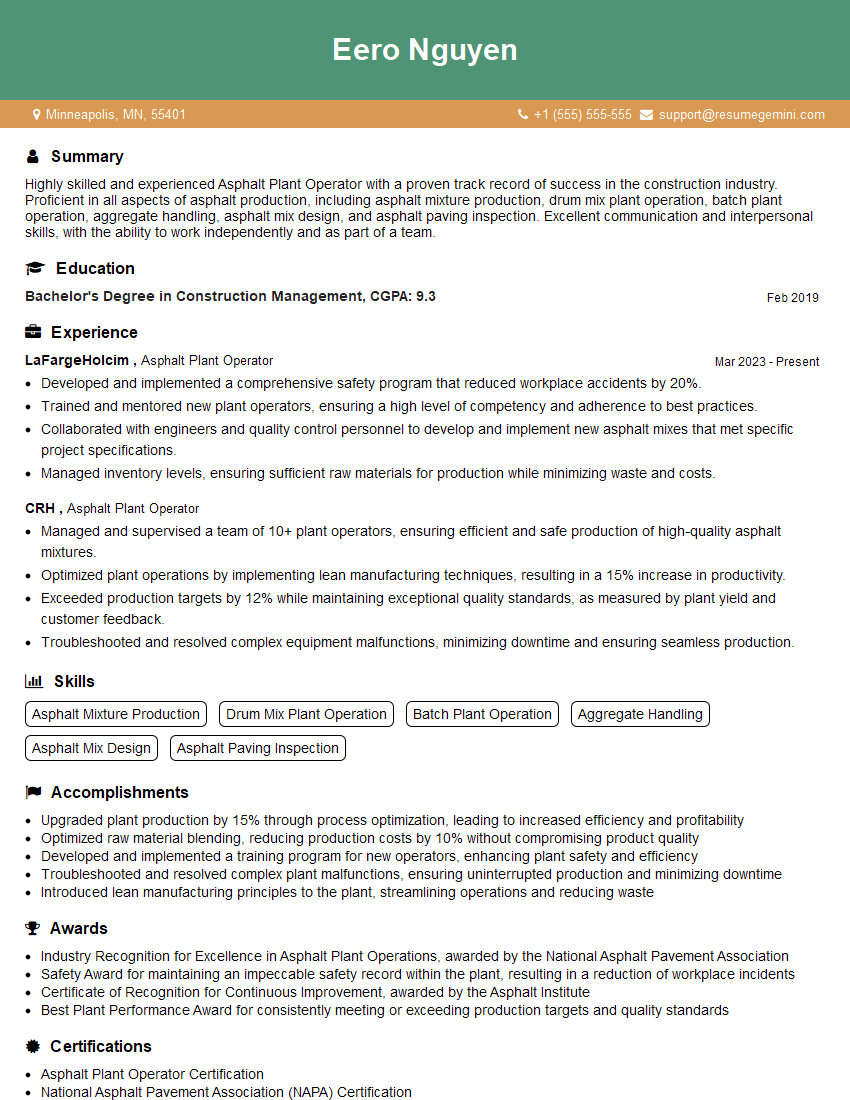Interviews are more than just a Q&A session—they’re a chance to prove your worth. This blog dives into essential Asphalt Equipment Operation and Maintenance interview questions and expert tips to help you align your answers with what hiring managers are looking for. Start preparing to shine!
Questions Asked in Asphalt Equipment Operation and Maintenance Interview
Q 1. Describe your experience operating asphalt pavers.
My experience with asphalt pavers spans over 10 years, encompassing various models and project scales. I’m proficient in operating both small and large pavers, from initial setup and screed adjustments to final paving and material management. For instance, on a recent highway project, I successfully paved over 5 miles of asphalt using a Vögele paver, maintaining consistent mat thickness and surface texture despite challenging weather conditions. This involved meticulously adjusting the screed’s crown and using the paver’s automated functions for optimal performance. I understand the importance of coordinating with other equipment operators, such as rollers and dump trucks, for a smooth and efficient paving process. Beyond basic operation, I also have experience troubleshooting mechanical issues and performing minor repairs to minimize downtime. My focus is always on ensuring high-quality, consistent paving results.
Q 2. Explain the process of asphalt compaction.
Asphalt compaction is crucial for achieving a durable and stable pavement structure. It involves using rollers to densify the hot asphalt mix, reducing its air voids and increasing its strength. The process typically begins with a lighter roller, such as a pneumatic roller, to achieve initial compaction and avoid surface damage. This is followed by heavier rollers, like static or vibratory rollers, to achieve the desired density at the required depth. The number of roller passes depends on factors like asphalt mix design, temperature, and desired density. Think of it like making a sandcastle: you first gently pack the sand (lighter roller) then firmly press it down (heavier roller) to get a sturdy structure. Monitoring asphalt temperature and adjusting roller speed and pressure is crucial to ensure proper compaction without damaging the surface. Improper compaction can lead to rutting, cracking, and premature pavement failure.
Q 3. How do you maintain optimal asphalt temperature during paving?
Maintaining optimal asphalt temperature is critical for achieving proper compaction and preventing premature hardening. The ideal temperature range varies depending on the asphalt mix design, but generally lies between 250°F and 350°F (121°C and 177°C). We monitor the temperature continuously using infrared thermometers or sensors integrated into the paver. Strategies to maintain this optimal range include: adjusting the feed rate of the hot mix from the dump trucks, using insulated trucks and keeping them covered, and adjusting the paving speed to match the asphalt’s cooling rate. In hot weather, we might need to increase the paving speed, while in cooler weather, a slower pace is needed. Consistent monitoring and proactive adjustments are key to preventing issues like premature hardening or inadequate compaction, leading to a higher quality final product.
Q 4. What are the common problems encountered with asphalt rollers?
Common problems encountered with asphalt rollers include hydraulic leaks, engine issues, drum vibrations, and tire wear (for pneumatic rollers). Hydraulic leaks can reduce roller performance and lead to costly repairs. Engine problems can range from minor issues like fuel filter clogs to major problems requiring engine overhaul. Drum vibrations often indicate imbalance or damage to the roller drum, potentially resulting in uneven compaction. Tire wear on pneumatic rollers necessitates timely replacement to prevent uneven compaction and potential damage to the asphalt surface. Regular inspections, preventative maintenance, and prompt repairs are essential to minimize downtime and ensure efficient and effective roller operation. One memorable incident involved a vibratory roller experiencing excessive vibrations due to an unbalanced drum; a timely diagnosis and repair prevented significant project delays.
Q 5. How do you troubleshoot a malfunctioning asphalt distributor?
Troubleshooting a malfunctioning asphalt distributor involves a systematic approach. First, we check the obvious: is the tank properly filled? Are the pumps primed and functioning correctly? Then, we move to more in-depth checks, assessing the spray bar nozzles for clogs or damage. We inspect the distribution system for leaks, check the pressure gauges, and verify the functionality of the controls. A common issue is a clogged nozzle leading to uneven distribution. In this case, cleaning or replacing the nozzle often solves the problem. More complex problems might involve checking the hydraulic system for leaks or malfunctions in the pump or motor. Electrical faults within the control system can also cause issues. A thorough understanding of the asphalt distributor’s mechanics, coupled with systematic troubleshooting, is essential to quickly identify and resolve these malfunctions, minimizing disruption to the paving process.
Q 6. Describe your experience with crack sealing techniques.
My crack sealing experience involves different techniques depending on the crack’s size and depth. For smaller cracks, we often use a hand-held caulking gun to apply sealant. For larger cracks, we might use a self-propelled crack sealing machine for more efficient application. Preparation is key: the cracks need to be cleaned thoroughly of debris before sealing to ensure proper adhesion. The selected sealant needs to be compatible with the existing asphalt. We often use hot-pour sealants for larger cracks for better durability and longevity. The sealant is melted and poured into the cleaned crack, followed by a compaction process to ensure proper filling. Post-application, we monitor the sealant for proper curing and adhesion. Effective crack sealing is crucial in preventing water ingress and further pavement damage, extending the life of the road surface.
Q 7. Explain the importance of preventative maintenance for asphalt equipment.
Preventative maintenance is paramount in ensuring the longevity and efficient operation of asphalt equipment. Regular inspections, lubrication, and component replacements are crucial. Think of it as regular check-ups for your car – you catch minor issues before they escalate into major problems. This includes things like daily pre-operational checks of fluid levels, tire pressures, and visual inspections for wear and tear. Regular servicing schedules, as per manufacturer recommendations, involve tasks such as changing engine oil and filters, cleaning and maintaining hydraulic systems, and inspecting and replacing worn-out parts. This minimizes unexpected breakdowns, leading to reduced downtime, lower repair costs, and increased equipment lifespan. A well-maintained equipment fleet contributes to increased productivity, safety, and the overall quality of the paving work, making it a financially prudent and operationally sound practice.
Q 8. What safety procedures do you follow when operating asphalt equipment?
Safety is paramount when operating asphalt equipment. My approach is built on a foundation of pre-operational checks, adherence to safety regulations, and consistent awareness of potential hazards.
- Pre-operational Checks: Before starting any machine, I meticulously inspect it for any mechanical faults, fluid leaks, or damaged components. This includes checking tire pressure, fluid levels (hydraulic oil, engine oil, coolant), and ensuring all safety devices like guards and emergency stops are functioning correctly.
- Personal Protective Equipment (PPE): I always wear appropriate PPE, including safety glasses, hearing protection, steel-toed boots, and a high-visibility vest. The type of PPE will vary depending on the specific task; for example, a respirator might be necessary when working with dust or fumes.
- Site Safety: I ensure the work area is clearly marked, traffic is controlled, and the surrounding area is free from obstructions. Communication with other workers on the site is key to preventing accidents.
- Emergency Procedures: I’m familiar with all emergency procedures and know how to react in case of a malfunction or accident. This includes knowing the location of fire extinguishers and emergency shut-off switches.
- Weather Conditions: I’m aware of how weather conditions can impact safety and adjust operations accordingly. For example, I won’t operate equipment in severe thunderstorms or high winds.
For instance, during a recent paving project, I noticed a loose bolt on the paver’s auger. Immediately, I stopped the machine, secured the area, and reported the issue to the supervisor before proceeding. This prevented a potential catastrophic failure and ensured the safety of myself and my coworkers.
Q 9. How do you identify and address asphalt surface defects?
Identifying and addressing asphalt surface defects requires a keen eye and understanding of the various types of defects. I typically use a combination of visual inspection and specialized tools.
- Visual Inspection: This involves a thorough examination of the asphalt surface, looking for cracks, potholes, rutting, raveling, and other signs of distress. I note the severity, location, and type of each defect.
- Specialized Tools: Depending on the situation, I might use tools like a crack meter to measure the width and depth of cracks, or a profilometer to measure the smoothness of the surface.
Once defects are identified, the appropriate repair method is selected. For instance, small cracks might be sealed with crack filler, while potholes require excavation and replacement of the damaged asphalt. More severe issues, like extensive rutting or alligator cracking, often necessitate a more extensive repair or even a complete resurfacing.
For example, during a routine inspection, I noticed alligator cracking starting to develop in a high-traffic area. I immediately documented the extent of the damage and recommended a preventative maintenance strategy involving patching and possible overlay in the near future. This prevented a larger and more costly repair later on.
Q 10. Describe your experience with different types of asphalt mixes.
My experience encompasses a variety of asphalt mixes, each with its unique properties and applications. The choice of mix depends on factors like the traffic volume, climate, and intended use of the pavement.
- Hot Mix Asphalt (HMA): This is the most common type, consisting of aggregates, asphalt cement, and fillers. I’ve worked with various HMA grades, ranging from dense-graded mixes for high-traffic areas to open-graded mixes for porous pavements. The specific gradation of aggregates significantly affects the mix’s strength, durability, and drainage properties.
- Stone Matrix Asphalt (SMA): This mix utilizes a higher percentage of stone and specialized asphalt cement to create a highly durable and stable pavement. SMA is excellent for heavy-traffic situations and steep grades, exhibiting increased resistance to rutting and stripping.
- Polymer-Modified Asphalt (PMA): PMA incorporates polymers to enhance the performance characteristics of the asphalt binder, such as increased elasticity and resistance to cracking. I’ve used PMA mixes where superior durability and crack resistance are essential.
Understanding the properties of each mix allows me to make informed decisions regarding equipment settings and construction methods, ensuring that the resulting pavement meets the required specifications. For example, when working with SMA, I need to adjust the paver’s screed settings to achieve the correct density and texture, unlike when working with standard HMA.
Q 11. What are the signs of wear and tear in asphalt equipment components?
Regular inspections are crucial for identifying signs of wear and tear in asphalt equipment components. These signs can range from minor issues to significant problems that need immediate attention.
- Excessive Vibration or Noise: This could indicate worn bearings, loose parts, or imbalance in rotating components like drums or rollers.
- Leaks: Fluid leaks (hydraulic oil, engine oil, coolant) are a clear sign of a problem that needs immediate attention. Ignoring leaks can lead to component failure.
- Unusual Wear on Tires or Tracks: Uneven wear patterns may point to misalignment, mechanical problems, or improper operation.
- Corrosion: Rust or corrosion on metal components can weaken the structure and reduce lifespan.
- Excessive Heat: Overheating components indicate a problem with cooling systems or lubrication.
- Reduced Performance: Noticeably decreased productivity or efficiency of the equipment, such as difficulty compacting or reduced paving output.
For instance, during an inspection, I noticed a significant vibration in the roller drum. This turned out to be a worn bearing. Early detection prevented potential damage to the entire drum assembly and costly repairs.
Q 12. How do you perform routine inspections on asphalt equipment?
Routine inspections are a cornerstone of preventative maintenance for asphalt equipment. My process involves a thorough visual check and a functional test of key components.
- Visual Inspection: This includes checking for leaks, damage to components, excessive wear, corrosion, and loose or missing parts. I carefully examine all moving parts, hydraulic lines, electrical connections, and safety devices.
- Functional Tests: This entails verifying that all systems and components are working correctly. For example, I’ll test hydraulic functions, engine performance, and the operation of all control mechanisms.
- Fluid Levels: I check and adjust engine oil, hydraulic oil, coolant, and fuel levels as needed.
- Lubrication: I apply lubrication to moving parts and joints, according to the manufacturer’s recommendations.
- Documentation: I maintain detailed records of all inspections and maintenance activities, noting any issues or repairs.
Following a standardized checklist ensures that no critical components are overlooked during the inspection. A well-maintained equipment log helps prevent costly breakdowns and extends the equipment’s lifespan.
Q 13. Explain the proper use and maintenance of asphalt cutting tools.
Asphalt cutting tools are essential for various tasks, such as creating joints, removing damaged asphalt, or preparing the surface for repairs. Proper use and maintenance are critical for safety and tool longevity.
- Proper Use: The selection of the right tool for the job is essential. Different types of cutters, such as saw cutters or planing machines, are used for specific tasks. The speed and depth of cut should be adjusted based on the asphalt’s condition and the tool’s specifications to avoid damaging the tool or causing unnecessary wear. Always follow the manufacturer’s instructions and safety precautions.
- Maintenance: Regular cleaning, lubrication, and sharpening are necessary. After each use, I thoroughly clean the tool to remove debris and asphalt residue. The blades or cutting edges need to be sharpened regularly to maintain their effectiveness and prevent excessive vibration. Lubrication of moving parts is important to reduce wear and friction. Inspect the tool for cracks or damage; replace any damaged or worn parts immediately.
For example, when using a saw cutter, I always ensure the blade is properly tensioned and sharp to minimize vibration and ensure a clean cut. I also utilize a safety guard during operation and employ appropriate PPE to avoid any injuries from the blade or flying debris.
Q 14. Describe your experience with asphalt plant operations.
My experience with asphalt plant operations includes overseeing the entire production process, from raw material handling and mixing to quality control and distribution.
- Raw Material Handling: I’m familiar with the procedures for storing, handling, and feeding aggregates and asphalt cement into the plant. This includes monitoring the quality and gradation of aggregates and ensuring the correct proportioning of materials.
- Mixing Process: I understand the various parameters that control the mixing process and how they impact the quality of the asphalt mix. This involves monitoring temperature, mixing time, and the addition of additives.
- Quality Control: I’m skilled in performing quality control tests, including measuring the mix’s temperature, density, and air voids. This ensures the mix meets the required specifications.
- Troubleshooting: I’ve successfully addressed various production issues, including blockages, equipment malfunctions, and deviations in mix quality. This involves identifying the root cause of the problem and implementing corrective measures.
- Safety and Compliance: I’m aware of all relevant safety regulations and environmental compliance requirements concerning asphalt plant operation and maintenance.
During a project involving a significant increase in production demands, I implemented improvements to the plant’s material handling system to enhance efficiency and prevent bottlenecks, resulting in a smoother production process and minimized downtime.
Q 15. How do you ensure the efficiency and productivity of asphalt equipment?
Ensuring the efficiency and productivity of asphalt equipment hinges on a multi-pronged approach encompassing preventative maintenance, operator training, and optimized operational strategies. Think of it like a well-oiled machine – each part needs to function optimally for the whole to perform at its best.
- Preventative Maintenance: Regular scheduled maintenance, following the manufacturer’s recommendations, is paramount. This includes things like checking fluid levels (engine oil, hydraulic fluid, transmission fluid), inspecting belts and hoses for wear and tear, and lubricating moving parts. For example, neglecting to change the oil in a paver’s auger system can lead to premature wear and costly repairs, significantly impacting productivity.
- Operator Training: Skilled operators are crucial. Proper training ensures operators understand the nuances of each machine, maximizing its capabilities while minimizing wear and tear. This includes safe operation procedures, understanding the machine’s limitations, and efficient paving techniques. A poorly trained operator might overload the screed, leading to uneven paving and material waste.
- Optimized Operations: This includes factors like proper material handling, efficient paving techniques (maintaining consistent speed and temperature), and effective communication between the team. For example, ensuring the asphalt supply is consistent and properly heated prevents delays and reduces material waste.
By diligently addressing these areas, we can significantly improve the lifespan and productivity of our asphalt equipment, ultimately translating to cost savings and project success.
Career Expert Tips:
- Ace those interviews! Prepare effectively by reviewing the Top 50 Most Common Interview Questions on ResumeGemini.
- Navigate your job search with confidence! Explore a wide range of Career Tips on ResumeGemini. Learn about common challenges and recommendations to overcome them.
- Craft the perfect resume! Master the Art of Resume Writing with ResumeGemini’s guide. Showcase your unique qualifications and achievements effectively.
- Don’t miss out on holiday savings! Build your dream resume with ResumeGemini’s ATS optimized templates.
Q 16. What are the environmental considerations in asphalt equipment operation?
Environmental considerations in asphalt equipment operation are increasingly important. We must minimize our impact on air and water quality, as well as noise pollution. Think green – reducing our footprint is vital.
- Emissions Control: Utilizing equipment that meets or exceeds emission standards is crucial. This often means using equipment with modern engines and emission control systems. Regular maintenance of these systems is equally important for effectiveness.
- Waste Management: Properly handling waste materials, such as used oil and filters, is critical. We need to follow all relevant regulations and utilize responsible disposal methods. Improper disposal can lead to environmental contamination.
- Noise Reduction: Asphalt equipment can be noisy. Employing noise reduction techniques, such as using appropriate mufflers and scheduling work during permissible hours, helps minimize disruptions to surrounding communities.
- Fuel Efficiency: Choosing fuel-efficient equipment and operating them optimally reduces greenhouse gas emissions. This also translates to cost savings for the project.
- Water Management: Minimizing water usage during operations and managing runoff effectively prevents contamination of water bodies.
By integrating these environmental best practices, we can conduct asphalt operations responsibly and minimize our impact on the environment.
Q 17. How do you handle unexpected equipment failures on a job site?
Unexpected equipment failures on a job site require a swift and methodical response. The key is preparedness and efficient troubleshooting.
- Safety First: The immediate priority is safety. Secure the area, ensuring the safety of personnel and the public. This might involve traffic control or machine shutdowns.
- Assessment and Diagnosis: Quickly assess the nature of the failure. This often involves checking warning lights, gauges, and listening for unusual sounds. If possible, consult the equipment manual for troubleshooting guidance.
- Communication: Communicate clearly with the project manager, maintenance team, and other relevant parties. Providing accurate information about the failure and its potential impact is vital.
- Temporary Solutions (if possible): If the failure isn’t critical, explore temporary solutions to keep the project moving. This might involve adjusting work procedures or using backup equipment.
- Repair or Replacement: Depending on the severity, initiate repair procedures or arrange for equipment replacement. This might involve contacting a service provider or utilizing on-site maintenance personnel.
- Root Cause Analysis: After the repair, conduct a thorough root cause analysis to understand why the failure occurred and prevent similar instances in the future. Proper documentation is crucial.
A well-defined emergency response plan and regular preventative maintenance significantly minimize the impact of unexpected equipment failures.
Q 18. Describe your experience with hydraulic systems in asphalt equipment.
Hydraulic systems are the backbone of most modern asphalt equipment, powering functions such as steering, lifting, and the operation of the screed. Understanding hydraulic systems is essential for efficient operation and maintenance.
- Experience with Diagnostics: I have extensive experience diagnosing hydraulic issues, including identifying leaks, troubleshooting faulty components (pumps, valves, cylinders), and determining the need for repairs or replacements. I’m proficient with pressure gauges and other diagnostic tools.
- Maintenance Procedures: I’m familiar with the importance of maintaining proper hydraulic fluid levels, regularly filtering the fluid, and ensuring the system is properly bled of air. These preventative measures significantly prolong the life of hydraulic components.
- Safety Considerations: I fully understand the safety hazards associated with high-pressure hydraulic systems and always adhere to safety protocols, including wearing appropriate protective gear and employing lockout/tagout procedures before any maintenance work is performed.
- Troubleshooting Examples: In one instance, I diagnosed a slow screed response on a paver by systematically checking the hydraulic lines for leaks and finally identifying a faulty hydraulic control valve. Replacing the valve quickly restored functionality.
My knowledge of hydraulic systems enables me to quickly diagnose problems, minimize downtime, and ensure the continued efficient operation of asphalt equipment.
Q 19. Explain the importance of proper lubrication for asphalt equipment.
Proper lubrication is critical for the longevity and efficiency of asphalt equipment. Think of it as the lifeblood of the machine – without it, components wear down prematurely.
- Reduced Friction and Wear: Lubricants reduce friction between moving parts, minimizing wear and tear. This extends the lifespan of components and reduces the frequency of repairs.
- Heat Dissipation: Lubricants help dissipate heat generated during operation, preventing overheating and potential damage.
- Corrosion Prevention: Many lubricants contain additives that protect against corrosion, ensuring the long-term integrity of metal parts.
- Types of Lubricants: Different components require different types of lubricants, tailored to their specific operating conditions and requirements. Using the incorrect lubricant can lead to damage.
- Regular Lubrication Schedule: Adhering to a strict lubrication schedule, as outlined in the equipment manual, is essential for preventative maintenance. This often involves regular grease fittings and oil changes.
Neglecting lubrication can result in catastrophic failures, leading to costly repairs and significant downtime. A diligent lubrication schedule is a fundamental aspect of preventative maintenance.
Q 20. What are the different types of asphalt equipment you are familiar with?
My experience encompasses a wide range of asphalt equipment, including:
- Asphalt Pavers: Various models, from small to large capacity, including both tracked and wheeled pavers. I’m proficient in their operation and maintenance, including screed adjustments and material flow control.
- Asphalt Rollers: Both static and vibratory rollers, used for compacting asphalt. I understand the different types and their appropriate applications, such as breakdown rollers and finish rollers.
- Asphalt Distributors: Used for applying liquid asphalt to the base layer. I’m experienced in their operation, including calibrating spray bars and maintaining consistent application rates.
- Material Transfer Vehicles: These transport hot asphalt mix from the plant to the paving site. Understanding their operation is critical for minimizing material cooling and segregation.
- Support Equipment: This includes equipment like loaders, excavators, and graders, used for material handling and site preparation.
This broad experience enables me to effectively manage and maintain a wide variety of asphalt equipment on diverse projects.
Q 21. How do you interpret and utilize equipment manuals and specifications?
Equipment manuals and specifications are essential resources for safe and efficient equipment operation and maintenance. They provide crucial information for troubleshooting, preventative maintenance, and ensuring compliance with safety standards. Think of them as the bible for your equipment.
- Troubleshooting: When equipment malfunctions, the manual provides step-by-step guidance on troubleshooting common problems and identifying potential causes.
- Preventative Maintenance: Manuals outline scheduled maintenance procedures, including lubrication intervals, fluid changes, and component inspections. Following these guidelines helps prevent costly breakdowns.
- Safety Procedures: They detail safe operating procedures, including lockout/tagout procedures, personal protective equipment requirements, and hazard warnings. Adherence to these procedures ensures the safety of operators and others on the job site.
- Specifications: The specifications section provides critical information such as operational limits, capacity, and technical details about the equipment’s components. Understanding these limits helps prevent equipment damage.
- Parts Identification: The manuals often include detailed diagrams and part lists, assisting in identifying and ordering replacement parts.
By diligently studying and utilizing these manuals, I ensure that all equipment is operated and maintained according to the manufacturer’s specifications, maximizing lifespan and performance.
Q 22. Describe your experience with diagnosing and repairing electrical issues in asphalt equipment.
Diagnosing and repairing electrical issues in asphalt equipment requires a systematic approach combining electrical troubleshooting skills with a strong understanding of the equipment’s schematics. I begin by visually inspecting the affected area for obvious problems like loose connections, damaged wiring, or burnt components. This often involves using a multimeter to check voltage, current, and continuity.
For example, if a paver’s auger drive motor isn’t functioning, I’d first check the power supply to the motor using the multimeter. If the voltage is absent, I’d trace the wiring back to the control panel, checking for blown fuses or tripped breakers. If the voltage is present but the motor is still unresponsive, I’d suspect a faulty motor or a problem within the motor’s control circuitry. This could necessitate further testing, potentially involving replacing individual components like capacitors or transistors, if identifying a faulty component is possible, otherwise motor replacement is the solution.
Beyond simple component testing, I’m experienced in working with more complex systems, understanding how various sensors, controllers and actuators interact and affect performance. Understanding the interaction of these systems is key to effective troubleshooting and repair.
Q 23. Explain the process of replacing worn parts in asphalt equipment.
Replacing worn parts in asphalt equipment follows a standardized procedure emphasizing safety and efficiency. First, I ensure the equipment is completely shut down and secured, following all lockout/tagout procedures. Then, I identify the specific part requiring replacement using the equipment’s manual or parts diagrams. I obtain the correct replacement part, ensuring it matches the specifications and is from a reputable supplier. Next, I carefully remove the worn part using appropriate tools, taking care not to damage surrounding components. The new part is then installed, following the manufacturer’s instructions precisely. After installation, I inspect the work and perform a functional test to ensure proper operation before resuming work. For example, replacing a worn screed plate involves removing the old plate using hydraulic jacks (if applicable), carefully cleaning the mounting surface, and installing the new plate using the same jacking system before carefully checking for accurate screed level.
Q 24. How do you ensure the safety of yourself and others while working with asphalt equipment?
Safety is paramount when working with asphalt equipment. My approach is based on a multi-layered strategy. Firstly, I meticulously follow all safety regulations and company policies. This includes wearing appropriate personal protective equipment (PPE), such as safety glasses, gloves, steel-toe boots, and high-visibility clothing. Secondly, I perform thorough pre-operational checks on the equipment before commencing any work. This ensures that all safety devices, like emergency stops and guards, are functioning correctly. Thirdly, I establish a safe work zone around the equipment and ensure that the area is properly secured, warning others of the operations. Finally, I am always mindful of potential hazards, such as moving parts, hot surfaces, and heavy loads. Communication is essential—I frequently communicate with co-workers and supervisors to ensure everyone is aware of my actions and potential risks.
Q 25. What are the key performance indicators (KPIs) you monitor for asphalt equipment?
Key performance indicators (KPIs) for asphalt equipment are critical to assess efficiency and identify potential problems. I monitor several key metrics: fuel consumption per ton of asphalt laid, production rate (tons per hour), pavement smoothness (measured by profile indicators), mat temperature consistency, and equipment uptime. Tracking these KPIs allows for quick identification of anomalies—for example, a sudden increase in fuel consumption might indicate a mechanical issue, while a decrease in production rate could signal a problem with the paving process or machine component. Regularly analyzing these KPIs is crucial for preventative maintenance scheduling, maximizing productivity, and minimizing operating costs. I typically use specialized software and data logging systems for accurate and comprehensive KPI tracking.
Q 26. Describe your experience with different types of asphalt repair techniques.
I have experience with various asphalt repair techniques, including pothole patching, crack sealing, and full-depth patching. Pothole patching involves cleaning the pothole, applying a tack coat, and filling it with hot mix asphalt, followed by compaction. Crack sealing focuses on preventing water infiltration into cracks, typically using specialized sealants appropriate for the crack width and severity. Full-depth patching is for larger areas requiring complete removal of the damaged asphalt layer, the application of a new base layer and final surfacing layer. The choice of technique depends on the severity and type of damage, weather conditions, and project requirements. I am proficient in selecting the correct materials and equipment for each repair method and ensuring the proper application for long-lasting results. Successful repair necessitates a comprehensive understanding of asphalt properties and their impact on the pavement structure.
Q 27. How do you maintain accurate records of equipment maintenance and repairs?
Maintaining accurate records is crucial for effective equipment management and preventative maintenance. I use a combination of methods. Firstly, I use computerized maintenance management systems (CMMS) to log all maintenance activities, including repairs, inspections, and parts replacements. These systems often offer automated features like scheduling and reporting. Secondly, I meticulously document all work performed, including the date, time, equipment involved, parts used, and labor hours. This documentation serves as a detailed history of the equipment and its performance. Thirdly, I keep physical copies of repair orders and invoices, serving as backup documentation. This comprehensive record-keeping system improves tracking, aids in budgeting, allows for better equipment life-cycle prediction, and simplifies warranty claims.
Q 28. Describe a time you had to troubleshoot a complex problem with asphalt equipment.
One challenging experience involved troubleshooting a seemingly intermittent failure in a paver’s screed leveling system. The problem was inconsistent—sometimes the screed would operate perfectly, other times it would malfunction, leading to uneven pavement. Initially, we suspected a faulty hydraulic component but extensive testing showed no obvious hydraulic leaks or failures. Eventually, after careful examination of the wiring harness, we discovered a poorly crimped wire connection within the screed’s control system. This loose connection intermittently interrupted the signal to the leveling mechanism. Once we repaired the crimped connection, the problem was immediately resolved. This experience underscored the importance of thorough investigation even when seemingly obvious solutions initially prove ineffective. It taught me the need to scrutinize all potential causes, particularly in complex electromechanical systems.
Key Topics to Learn for Asphalt Equipment Operation and Maintenance Interview
- Equipment Operation: Understanding the mechanics and operation of various asphalt equipment such as pavers, rollers, and excavators. This includes safe operating procedures, pre-operational checks, and efficient techniques for optimal performance.
- Preventive Maintenance: Mastering the principles of preventative maintenance, including regular inspections, lubrication schedules, and component replacement to minimize downtime and extend equipment lifespan. Practical application involves understanding manufacturer’s recommendations and conducting thorough inspections.
- Troubleshooting and Repair: Developing the ability to diagnose and resolve common mechanical and hydraulic issues. This includes understanding basic troubleshooting techniques, interpreting diagnostic codes, and performing minor repairs. Consider exploring hydraulic systems, engine diagnostics, and electrical systems.
- Safety Procedures: Demonstrating a thorough understanding of all relevant safety regulations and procedures for operating and maintaining asphalt equipment. This includes personal protective equipment (PPE) usage, hazard identification, and emergency response protocols.
- Material Handling: Understanding the properties of asphalt materials and their impact on equipment operation and maintenance. This includes knowledge of different asphalt grades, temperature control, and proper material handling techniques.
- Quality Control: Familiarity with quality control measures to ensure the proper compaction and smoothness of asphalt surfaces. This includes understanding density testing, surface smoothness measurements, and adherence to project specifications.
- Documentation and Record Keeping: Understanding the importance of accurate and timely documentation of maintenance activities, repairs, and equipment performance. This includes logbooks, work orders, and other relevant documentation.
Next Steps
Mastering Asphalt Equipment Operation and Maintenance opens doors to rewarding careers with excellent growth potential. Advancement opportunities often include supervisory roles, specialized maintenance positions, and project management. To maximize your job prospects, it’s crucial to present your skills effectively. Creating an ATS-friendly resume is key to getting your application noticed. ResumeGemini is a trusted resource to help you build a professional and impactful resume that highlights your qualifications. Examples of resumes tailored to Asphalt Equipment Operation and Maintenance are available to guide you.
Explore more articles
Users Rating of Our Blogs
Share Your Experience
We value your feedback! Please rate our content and share your thoughts (optional).
What Readers Say About Our Blog
Interesting Article, I liked the depth of knowledge you’ve shared.
Helpful, thanks for sharing.
Hi, I represent a social media marketing agency and liked your blog
Hi, I represent an SEO company that specialises in getting you AI citations and higher rankings on Google. I’d like to offer you a 100% free SEO audit for your website. Would you be interested?
